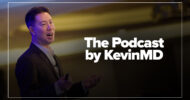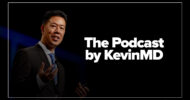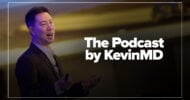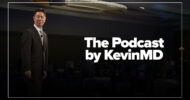Subscribe to The Podcast by KevinMD. Watch on YouTube. Catch up on old episodes!
Public policy analyst Julia Drydyk discusses her article “Human trafficking isn’t what you think: Why education is key to stopping it.” Julia clarifies the crucial distinction between human smuggling and human trafficking, explaining that trafficking involves exploitation through coercion regardless of geographic movement, often occurring within communities rather than solely at borders. She addresses how popular media perpetuates misconceptions, leading people to overlook the subtle, psychological tactics traffickers employ, often involving individuals known and trusted by the victim. Julia emphasizes that traffickers target vulnerabilities like poverty, homelessness, and mental health disorders, posing as caring figures to establish control. She highlights the urgent need for public education to recognize the real signs of trafficking, such as behavioral changes, unexplained absences, or signs of control by another person, enabling Canadians to bridge the gap between good intentions and effective action.
Our presenting sponsor is Microsoft Dragon Copilot.
Microsoft Dragon Copilot, your AI assistant for clinical workflow, is transforming how clinicians work. Now you can streamline and customize documentation, surface information right at the point of care, and automate tasks with just a click.
Part of Microsoft Cloud for Healthcare, Dragon Copilot offers an extensible AI workspace and a single, integrated platform to help unlock new levels of efficiency. Plus, it’s backed by a proven track record and decades of clinical expertise—and it’s built on a foundation of trust.
It’s time to ease your administrative burdens and stay focused on what matters most with Dragon Copilot, your AI assistant for clinical workflow.
VISIT SPONSOR → https://aka.ms/kevinmd
SUBSCRIBE TO THE PODCAST → https://www.kevinmd.com/podcast
RECOMMENDED BY KEVINMD → https://www.kevinmd.com/recommended
Transcript
Kevin Pho: Hi, and welcome to the show. Subscribe at KevinMD.com/podcast. Today we welcome Julia Drydyk. She’s a public policy analyst. Today’s KevinMD article is, “Human trafficking isn’t what you think: Why education is key to stopping it.” Julia, welcome to the show.
Julia Drydyk: Thank you so much for having me.
Kevin Pho: Let’s briefly share your story and journey and what led you to contribute this article on KevinMD.
Julia Drydyk: I’m currently the executive director at the Canadian Center to End Human Trafficking, and I joined about six years ago. Before that, I spent about 15 years working in research, public policy, and evaluation on issues like poverty reduction, community development, social inclusion, and employment.
I was really drawn to the issue of human trafficking because it exists at the intersection of where all of those other systems fail. A big part of our article is that human trafficking isn’t what you think. It’s largely an intersectional issue. It looks a lot more like intimate partner violence than smuggling.
Traffickers are looking for people with vulnerabilities in their lives, and that’s usually where these bigger systems are failing them. It’s a huge privilege to work in this space. It’s hard, but it definitely gives me a lot of passion every day.
Kevin Pho: Before going into your article, let’s have some brief definitions to get everyone up to speed. What’s the definition of human trafficking?
Julia Drydyk: Put really simply, human trafficking is when you’re exploiting someone else for your own profit or gain. Unlike what a lot of people think or maybe even see in the movies, it doesn’t necessarily, and it often doesn’t, involve smuggling or moving people across borders. It’s really when you’re taking advantage of someone for your own profit.
In Canada, and I’d argue probably in the U.S., the two biggest forms of human trafficking are sex trafficking and also labor trafficking. It’s when someone is controlling, deceiving, manipulating, or threatening someone, either in the commercial sex industry or in other forms of labor, to do things against their will for someone else’s profit. There always needs to be that third party that is profiting from the exploitation.
Kevin Pho: Then going to your KevinMD article, what are some myths? What are some misconceptions that most of us have about human trafficking?
Julia Drydyk: This is one of the biggest challenges we have in the fight to end human trafficking: people, again, think of the movie Taken. They think that this means people are being kidnapped off the street or in their homes, smuggled across borders in shipping containers, chained to radiators, and then being sexually abused and exploited.
That can happen, but more often than not, and we see this all the time in operating the Canadian Human Trafficking hotline, it’s actually someone the victim knows, loves, and trusts. They embed themselves as someone, like a boyfriend, a friend, or, horrifically enough, it can also be a family member. In the case of the boyfriend trafficker, they’ll start by being a Romeo. They’ll find out the person’s greatest dreams and aspirations and their biggest fears. They’ll give them and shower them with everything they’ve ever wanted. That can look like expensive clothes, bags, and purses. It can also just mean a roof over their head, stable meals, and the promise of unconditional love.
Quite quickly, sometimes in a matter of weeks or months, they start clawing that back. Then they start telling them, “You owe me something. Think of all the money, everything I’ve given you. You need to start pitching in.” They’ll use that as a way to groom them into the commercial sex industry. Often, when you’re at the peak stage of exploitation, victims have no control over their lives. They don’t control when they eat, when they sleep, who they see, or how many sexual activities they have to do in exchange for money every day. Overwhelmingly, the vast majority of the profits all go to the trafficker. This is all for their profit, and it’s largely through that emotional control and coercion.
There is often physical violence, but more often than not, it’s that psychological bond that’s used to threaten and to keep people in this horrible situation.
Kevin Pho: It seems to be that in the situation that you described, where the perpetrator could be a boyfriend, the Romeo, and it eventually slowly descends into commercial exploitation and being groomed, there are steps in between where some can think that there may be some off-ramp. In terms of a typical path for a trafficking case, does the victim reach out for help? What kind of support systems exist before they get into that situation where they’re commercially exploited?
Julia Drydyk: That’s a great question, and that’s why education for everyone is so important. Traffickers will often start grooming them into the commercial sex industry, even by doing things like webcamming or getting sexual photos. They’ll use that to wedge them against their family and friends. They’ll hold it against them and say, “You have to do what I say, or I’m going to tell them what you did, and no one is going to love you again.” They use it as a way to distance them from everyone else, make it feel like there’s nowhere that they can go and that no one will love them.
In operating the Canadian Human Trafficking hotline, the second-biggest group of people contacting us, aside from victims themselves, are friends and family members who have no idea what to do. They don’t know how to have the conversation that they’re worried about someone, that they’re withdrawing, that they’re concerned about their behavior. But again, there’s sometimes a lot of judgment that they have to overcome.
What we’re trying to do is equip parents, friends, and family members with the tools to have these really hard conversations, but to say, “I see you. I love you unconditionally, and we’re here to help.” I think that’s the most important thing in those early stages: to be able to have those conversations. To support that work, and it’s available on our website, we actually developed a guide for people to start talking about it. How do you actually start having these conversations? No one likes talking about sex with the young people in their lives unless you’re a sex educator. Providing really tangible tools and resources for people to broach the conversation often won’t actually succeed in the first one, but it can give them a bit of a lifeline and some resources to know how to make sure that they’re still there and that there’s help available when the person is ready to leave.
Kevin Pho: Before I ask about potential paths forward, let me ask about the prevalence. What kind of numbers are we talking about in Canada? What kind of demographics and age groups are affected, just to get a sense of how prevalent this is?
Julia Drydyk: The data we have is just the tip of the iceberg. We operate the Canadian Human Trafficking Hotline. We’re available 24/7, 365 days a year. We operate across Canada with partners across Canada. We identify about 500 to 600 individual victims and survivors every year. But again, that’s just the tip of the iceberg. Those are just the people contacting our hotline.
I would say all of law enforcement combined in Canada identifies about the same amount. Between law enforcement and the hotline, we’re identifying close to a thousand or 1,200. But again, there are huge barriers for victims and survivors contacting law enforcement. Not everyone needs a hotline, and we really just look to connect people with services in their community. We’re not really capturing data from those frontline services, but what we hear from our community partners is that the issue is way bigger than any data we’ve collected.
Unfortunately, we’re also finding that the more education and awareness we do, when you go into a school and start talking about the realities, you have to be prepared for disclosure. It is very common in almost every piece of education and awareness we do that once people know what it really looks like, a light bulb goes off. It might not be them, it might be a friend. It might be, if you’re an adult, a friend’s kid, someone in the community, and they realize, “Oh my God, this isn’t what I thought. I’m pretty sure that person was being trafficked and exploited.”
Kevin Pho: And the victims who are being trafficked, what are some demographic characteristics?
Julia Drydyk: For sex trafficking, the overwhelming demographics are that in Canada, they’re Canadian women and girls. We do know that men and young men, and also trans folks and queer folks, are also being trafficked, but again, it’s not being picked up in the same way. When it comes to sex trafficking, this is largely an issue again of Canadian women and girls.
Labor trafficking, on the other hand, is very different. That’s actually where you’re seeing a lot of migrant workers, actually in Canada legally through our temporary foreign worker program, who are being really horribly abused and systematically exploited by their employers.
Kevin Pho: In terms of paths forward from the perspective of a potential victim being trafficked, tell us what kind of signs they should be looking out for and what kind of options they have when they come to that realization that they may be being trafficked.
Julia Drydyk: From a community perspective, if this is someone in your life, usually there’s a really noticeable withdrawal and change in behavior. They might stop going to school or attending activities. They’re not talking to their friends; again, they’re getting really isolated. They might also start doing things like providing canned answers, being really secretive about new people in their lives, and not being forthcoming. You really can’t get at where they’re going or what they’re doing. They may be showing signs of intimidation and fear, and these can be really subtle.
Then we also see in the grooming phase that there is love bombing: really expensive clothes, nails, hair—things that just don’t make sense for their normal income. Of course, there could also be signs of physical abuse, so cuts and bruises, those types of things.
From a clinical perspective, if you’re a health care provider, you might not see that change in behavior socially. But usually, what you will see are things like someone with them who’s not leaving, so being surveyed, speaking for them. Again, the signs of fear and intimidation can be subtle, so often it’s not speaking for themselves. Often traffickers will actually hold their ID, so really showing signs of control, and it might look very similar to other forms of intimate partner or domestic violence. You may see that person who’s speaking for the other person, needing to know everything and not letting them be alone at any point.
Kevin Pho: And in terms of the next step, if they realize some of these signs, would it be to call your hotline?
Julia Drydyk: Yes, we encourage anyone to call the hotline at +1 833-900-1010. We’ve partnered with over a thousand frontline service delivery partners across the country, and we also have specialized reporting protocols with law enforcement in pretty much every community across Canada.
We only report when there is a legal duty to do so or if we have the consent of the person. Involving law enforcement can actually make things more dangerous in the short run, but we do have those relationships. We also talked to a lot of frontline service delivery partners about this and encourage them to develop safety protocols and policies so that you’ve actually got tools to be able to maybe get the person alone, ask them if they’re OK, and even share resources like the Canadian Human Trafficking Hotline.
Really be thoughtful about how they engage. Similar to intimate partner violence, the most dangerous time for someone is when they’re leaving. That is the most likely time for physical assaults, even murder and death. We need to be really careful and thoughtful about what that exit is. Often, if you rush it or if you’re not working with the victim to really understand the safety considerations, that’s when the worst possible outcomes could happen.
Kevin Pho: What are some things definitely not to do? You implied a few things, but just to spell it out, what are some things that if we’re concerned about a loved one being trafficked or if someone’s being trafficked themselves, what are some things definitely not to do?
Julia Drydyk: We get a lot of this, even in bystanders thinking that they can just intervene and solve the problem themselves. Again, there’s a lot of danger there. You need to be thoughtful about your own physical safety and what that means in terms of potential attacks, assault, and violence for yourself.
If you know the person well, I think it is about starting that conversation around safety and having them access supports. We do a lot of safety planning through the hotline. We’re a resource; based on your situation, we can work with you to develop a plan to exit in a way that’s going to mitigate as many risks as possible.
If it is urgent and if there’s a lot of immediate risk, call 911. We’re not saying don’t call 911 if you’re in immediate danger. But often, trying to connect people with services in their community is the best way forward because it’s complicated, it’s dangerous, and it’s not easy. You really need a whole community around to make sure that the person is exiting safely and that they’ve got somewhere safe to land when they go.
Kevin Pho: Give us a sense of who these traffickers are. You mentioned the movie Taken, for instance. Are they organized gangs? What are some misconceptions about who human traffickers are in general?
Julia Drydyk: Traffickers can be anyone. In research that we conducted in 2020 on human trafficking corridors in Canada, there can be gang involvement, but they’re usually working independently of that gang. One of the reasons that trafficking is growing is because it’s a high-profit, low-risk crime. Because the evidence is so much based on individual victim testimony, it’s actually really hard to lay charges and to prosecute. They know this, and so they’re doing it on the side and knowing how to launder and hide the money to be able to profit as much as possible, sometimes even putting the debts in the victim’s name as a way of masking it.
We’ve seen every demographic, every type of person. We do see overwhelmingly that traffickers of sex trafficking victims are men, males, male-identified. But we also know that increasingly, victims are also being coerced into trafficking other people as a way to reduce the threat on themselves. Their quotas are reduced. They might be threatened less or be beaten less if they’re actually recruiting and overseeing others. There’s a bunch of layers to all of this.
Kevin Pho: We’re talking to Julia Drydyk. She’s a public policy analyst. Today’s KevinMD article is, “Human trafficking isn’t what you think: Why education is key to stopping it.” Julia, let’s end with some take-home messages that you’d like to leave with the KevinMD audience.
Julia Drydyk: If something in your gut feels off, it probably is. Please do not hesitate to call the Canadian Human Trafficking Hotline at 1-833-900-1010. It doesn’t need to be an emergency situation. We’re really there to meet everyone where they’re at. If you are in the States, you’re also welcome to call, and we can also refer you to American resources through the U.S. National Human Trafficking Hotline. We’re here for you 24/7, 365.
Kevin Pho: Julia, thank you so much for sharing your perspective and insight, and thanks again for coming on the show.
Julia Drydyk: Thanks for having me.






















![A leader's journey through profound grief and loss [PODCAST]](https://kevinmd.com/wp-content/uploads/The-Podcast-by-KevinMD-WideScreen-3000-px-4-190x100.jpg)





